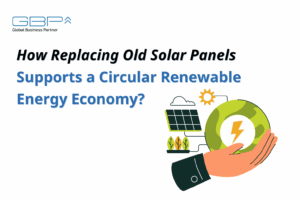How Replacing Old Solar Panels Supports a Circular Renewable Energy Economy
01 The Challenge: Aging Solar Panels in a Fast-Growing Industry
The first large-scale solar installations of the early 2000s are now reaching their 20–25-year lifespan. Many of these panels still function but no longer operate efficiently enough for modern energy demands.
If left unaddressed, millions of aging panels could soon turn into electronic waste, posing an environmental challenge that contradicts the purpose of renewable energy.
That’s where responsible solar replacement and recycling come in.
02 What Is a Circular Renewable Energy Economy?
A circular economy aims to minimize waste and maximize resource efficiency by reusing, refurbishing, or recycling materials instead of discarding them.
In the context of renewable energy, it means ensuring that every solar component — from PV cells to inverters — continues to deliver value even after its first life cycle.
Replacing old solar panels with next-generation models while responsibly managing the old ones is a key step in achieving that circular goal.
03 Why Replacement Is Better Than Disposal
Instead of discarding underperforming panels, replacement and repowering help retain existing infrastructure while boosting system performance.
Here’s how:
Reuse
Mounting racks and electrical components are often still usable.
Recycle
Old panels contain recyclable materials such as aluminum, glass, and silicon.
Upgrade
Modern panels deliver 20–30% higher efficiency with better durability and energy conversion.
The result? A smarter, cleaner transition that supports both economic and environmental sustainability.
04 GBP’s Role in Building a Sustainable Solar Ecosystem
At GBP, we believe renewable energy should evolve without leaving waste behind.
That’s why our solar technology and repowering solutions are designed not only for efficiency but also for longevity and recyclability.
Our initiatives support:
1.Recycling of end-of-life solar panels through certified partners
2.Upgrading older systems for improved energy output
3.Reducing lifecycle emissions through material reuse
Together, these actions form the backbone of a sustainable, circular solar ecosystem that keeps renewable energy truly renewable.
05 The Future: From Linear to Circular Solar Energy
The solar industry is shifting from a “produce–use–discard” model to a “produce–use–recover–renew” cycle.
As governments worldwide set stricter recycling mandates, and as consumers demand greener solutions, companies like GBP are leading the charge toward a closed-loop renewable energy system.
In the near future, every replaced solar panel could become the raw material for the next generation — reducing carbon impact and driving long-term sustainability.

